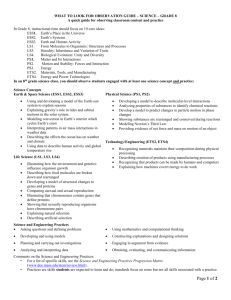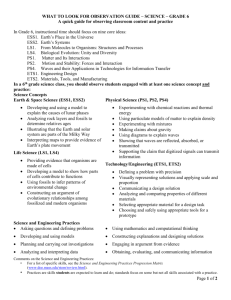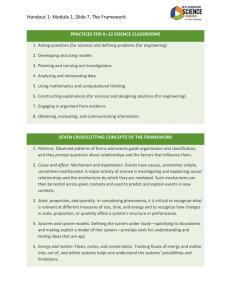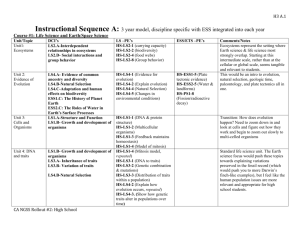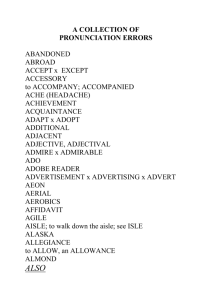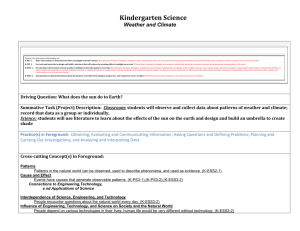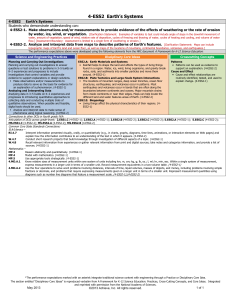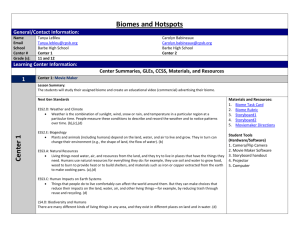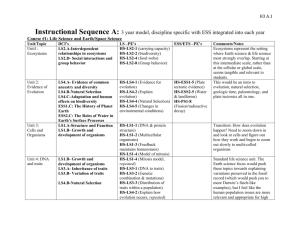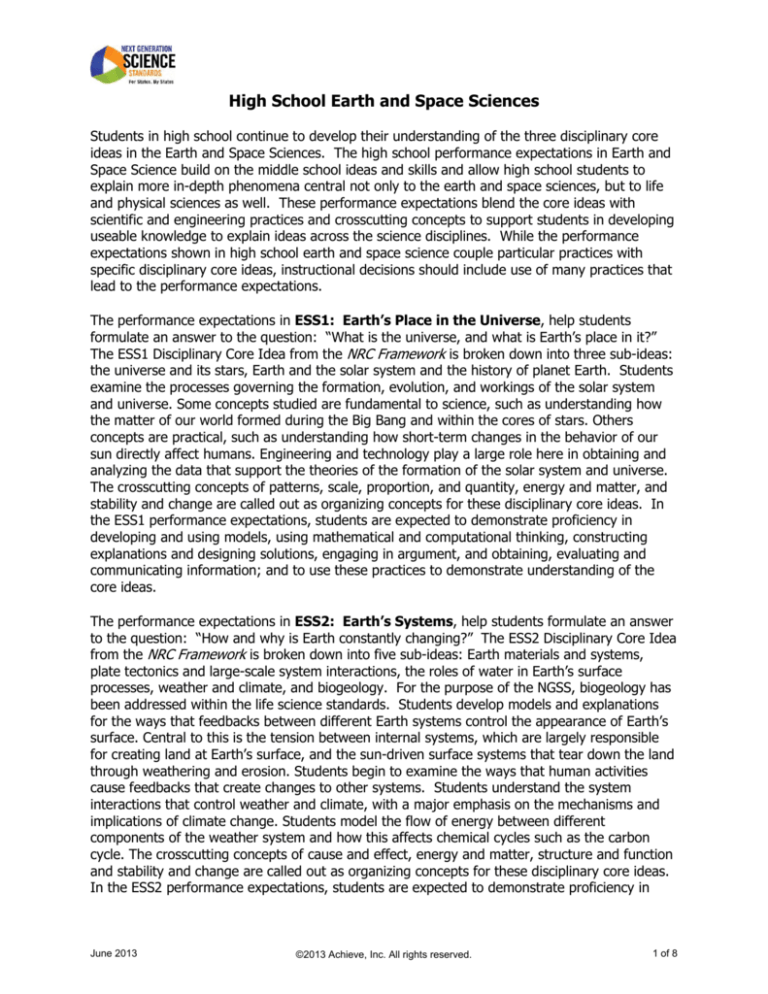
High School Earth and Space Sciences
Students in high school continue to develop their understanding of the three disciplinary core
ideas in the Earth and Space Sciences. The high school performance expectations in Earth and
Space Science build on the middle school ideas and skills and allow high school students to
explain more in-depth phenomena central not only to the earth and space sciences, but to life
and physical sciences as well. These performance expectations blend the core ideas with
scientific and engineering practices and crosscutting concepts to support students in developing
useable knowledge to explain ideas across the science disciplines. While the performance
expectations shown in high school earth and space science couple particular practices with
specific disciplinary core ideas, instructional decisions should include use of many practices that
lead to the performance expectations.
The performance expectations in ESS1: Earth’s Place in the Universe, help students
formulate an answer to the question: “What is the universe, and what is Earth’s place in it?”
The ESS1 Disciplinary Core Idea from the NRC Framework is broken down into three sub-ideas:
the universe and its stars, Earth and the solar system and the history of planet Earth. Students
examine the processes governing the formation, evolution, and workings of the solar system
and universe. Some concepts studied are fundamental to science, such as understanding how
the matter of our world formed during the Big Bang and within the cores of stars. Others
concepts are practical, such as understanding how short-term changes in the behavior of our
sun directly affect humans. Engineering and technology play a large role here in obtaining and
analyzing the data that support the theories of the formation of the solar system and universe.
The crosscutting concepts of patterns, scale, proportion, and quantity, energy and matter, and
stability and change are called out as organizing concepts for these disciplinary core ideas. In
the ESS1 performance expectations, students are expected to demonstrate proficiency in
developing and using models, using mathematical and computational thinking, constructing
explanations and designing solutions, engaging in argument, and obtaining, evaluating and
communicating information; and to use these practices to demonstrate understanding of the
core ideas.
The performance expectations in ESS2: Earth’s Systems, help students formulate an answer
to the question: “How and why is Earth constantly changing?” The ESS2 Disciplinary Core Idea
from the NRC Framework is broken down into five sub-ideas: Earth materials and systems,
plate tectonics and large-scale system interactions, the roles of water in Earth’s surface
processes, weather and climate, and biogeology. For the purpose of the NGSS, biogeology has
been addressed within the life science standards. Students develop models and explanations
for the ways that feedbacks between different Earth systems control the appearance of Earth’s
surface. Central to this is the tension between internal systems, which are largely responsible
for creating land at Earth’s surface, and the sun-driven surface systems that tear down the land
through weathering and erosion. Students begin to examine the ways that human activities
cause feedbacks that create changes to other systems. Students understand the system
interactions that control weather and climate, with a major emphasis on the mechanisms and
implications of climate change. Students model the flow of energy between different
components of the weather system and how this affects chemical cycles such as the carbon
cycle. The crosscutting concepts of cause and effect, energy and matter, structure and function
and stability and change are called out as organizing concepts for these disciplinary core ideas.
In the ESS2 performance expectations, students are expected to demonstrate proficiency in
June 2013
©2013 Achieve, Inc. All rights reserved.
1 of 8
developing and using models, planning and carrying out investigations, analyzing and
interpreting data, and engaging in argument; and to use these practices to demonstrate
understanding of the core ideas.
The performance expectations in ESS3: Earth and Human Activity help students formulate
an answer to the question: “How do Earth’s surface processes and human activities affect each
other?” The ESS3 Disciplinary Core Idea from the NRC Framework is broken down into four
sub-ideas: natural resources, natural hazards, human impact on Earth systems, and global
climate change. Students understand the complex and significant interdependencies between
humans and the rest of Earth’s systems through the impacts of natural hazards, our
dependencies on natural resources, and the significant environmental impacts of human
activities. Engineering and technology figure prominently here, as students use mathematical
thinking and the analysis of geoscience data to examine and construct solutions to the many
challenges facing long-term human sustainability on Earth. The crosscutting concepts of cause
and effect, systems and system models, and stability and change are called out as organizing
concepts for these disciplinary core ideas. In the ESS3 performance expectations, students are
expected to demonstrate proficiency in developing and using analyzing and interpreting data,
mathematical and computational thinking, constructing explanations and designing solutions
and engaging in argument; and to use these practices to demonstrate understanding of the
core ideas.
June 2013
©2013 Achieve, Inc. All rights reserved.
2 of 8
HS-ESS1 Earth’s Place in the Universe
HS-ESS1 Earth’s Place in the Universe
Students who demonstrate understanding can:
HS-ESS1-1.
Develop a model based on evidence to illustrate the life span of the sun and the role of nuclear fusion in the
sun’s core to release energy that eventually reaches Earth in the form of radiation. [C larification S tatement: E mphasis is
on the energy transfer mechanisms that allow energy from nuclear fusion in the sun’s core to reach E arth. E xamples of ev idenc e for the model include
observ ations of the masses and lifetimes of other stars, as w ell as the w ay s that the sun’s radiation v aries due to sudden solar flares (“space w eather”), the 11y ear sunspot cy cle, and non-cy clic v ariations ov er centuries.] [A ssessment Boundary : A ssessment does not include details of the atomic and sub-atomic
processes inv olv ed w ith the sun’s nuclear fusion.]
HS-ESS1-2.
Construct an explanation of the Big Bang theory based on astronomical evidence of light spectra, motion of
distant galaxies, and composition of matter in the universe. [C larification S tatement: E mphasis is on the astronomical ev idence of
the red shift of light from galaxies as an indication that the univ erse is currently expanding, the cosmic microw av e background as the remnant radiation from the
Big Bang, and the observ ed composition of ordinary matter of the univ erse, primarily found in stars and interstellar gases (from the spectra of electromagnetic
radiation from stars), w hich matches that predicted by the Big Bang theory (3/4 hy drogen and 1/4 helium).]
HS-ESS1-3.
Communicate scientific ideas about the way stars, over their life cycle, produce elements.
HS-ESS1-4.
Use mathematical or computational representations to predict the motion of orbiting objects in the solar
system. [C larification S tatement: E mphasis is on N ew tonian grav itational law s gov erning orbital motions, w hich apply to human -made satellites as w ell as
[C larification S tatement:
E mphasis is on the w ay nucleosy nthesis, and therefore the different elements created, v aries as a function of the mass of a s tar and the stage of its lifetime.]
[A ssessment Boundary : Details of the many different nucleosy nthesis pathw ay s for stars of differing masses are not assessed.]
planets and moons.] [A ssessment Boundary : M athematical representations for the grav itational attraction of bo dies and Kepler’s Law s of orbital motions should
not deal w ith more than tw o bodies, nor inv olv e calculus.]
HS-ESS1-5.
Evaluate evidence of the past and current movements of continental and oceanic crust and the theory of plate
tectonics to explain the ages of crustal rocks. [C larification S tatement: E mphasis is on the ability of plate tectonics to explain the ages of
crustal rocks. E xamples include ev idence of the ages oceanic crust increasing w ith distance from mid-ocean ridges (a result of plate spreading) and the ages of
N orth A merican continental crust increasing w ith distance aw ay from a central ancient core (a result of past plate interactions).]
HS-ESS1-6.
Apply scientific reasoning and evidence from ancient Earth materials, meteorites, and other planetary
surfaces to construct an account of Earth’s formation and early history. [C larification S tatement: E mphasis is on using
av ailable ev idence w ithin the solar sy stem to reconstruct the early history of E arth, w hich formed along w ith the rest of the solar sy stem 4.6 billion y ears ago.
E xamples of ev idence include the absolute ages of ancient materials (obtained by radiometric dating of meteorites, moon rocks, and E ar th’s oldest minerals), the
sizes and compositions of solar sy stem objects, and the impact cratering record of planetary surfaces.]
The performance expectations abov e w ere dev eloped using the follow ing elements from the N RC document A F ramew ork for K-12 S cience Education:
Science and Engineering Practices
Disciplinary Core Ideas
Crosscutting Concepts
Developing and Using M odels
ESS1 .A : The Universe and Its Stars
P atter ns
M odeling in 9–12 builds on K–8 experiences and progresses to
The star called the sun is changing and w ill burn out ov er
E mpirical ev idence is needed to identify
using, sy nthesizing, and dev eloping models to predict and show
a lifespan of approximately 10 billion y ears. (H S -E S S 1-1)
patterns. (H S -E S S 1-5)
relationships among v ariables betw een sy stems and their
The study of stars’ light spectra and brightness is used to
Scale, P r oportion, and Q uantity
components in the natural and designed w orld(s).
identify compositional elements of stars, their
The significance of a phenomenon is
Dev elop a model based on ev idence to illustrate the
mov ements, and their distances from E arth. (H S -E S S 1dependent on the scale, proportion, and
relationships betw een sy stems or betw een components of a
2),(H S -E S S 1-3)
quantity at w hich it occurs. (H S -E S S 1-1)
sy stem. (H S -E S S 1-1)
The Big Bang theory is supported by observ ations of
A lgebraic thinking is used to examine
Using M athematical and C omputational Thinking
distant galaxies receding from our ow n, of the measured
scientific data and predict the effect of a
M athematical and computational thinking in 9–12 builds on K–8
composition of stars and non-stellar gases, and of the
change in one v ariable on another (e.g.,
experiences and progresses to using algebraic thinking and
maps of spectra of the primordial radiation (cosmic
linear grow th v s. exponential grow th).
analy sis, a range of linear and nonlinear functions including
microw av e background) that still fills the univ erse. (H S (H S -E S S 1-4)
trigonometric functions, exponentials and logarithms, and
E S S 1-2)
Ener gy and M atter
computational tools for statistical analy sis to analy ze, represent,
O ther than the hy drogen and helium formed at the time
E nergy cannot be created or destroy ed–
and model data. S imple computational simulations are created and
of the Big Bang, nuclear fusion w ithin stars produces all
only mov ed betw een one place and
used based on mathematical models of basic assumptions.
atomic nuclei lighter than and including iron, and the
another place, betw een objects and/or
U se mathematical or computational representations of
process releases electromagnetic energy . H eav ier
fields, or betw een sy stems. (H S -E S S 1-2)
phenomena to describe explanations. (H S -E S S 1-4)
elements are produced w hen certain massiv e stars
In nuclear processes, atoms are not
C onstr ucting Explanations and Designing Solutions
achiev e a supernov a stage and explode. (H S -E S S 1conserv ed, but the total number of
C onstructing explanations and designing solutions in 9–12 builds on
2),(H S -E S S 1-3)
protons plus neutrons is conserv ed. (H S K–8 experiences and progresses to explanations and designs that
ESS1 .B: Ear th and the Solar System
E S S 1-3)
are supported by multiple and independent student-generated
Kepler’s law s describe common features of the motions
Stability and C hange
sources of ev idence consistent w ith scientific ideas, principles, and
of orbiting objects, including their elliptical paths around
M uch of science deals w ith constructing
theories.
the sun. O rbits may change due to the grav itational
explanations of how things change and
C onstruct an explanation based on v alid and reliable ev idence
effects from, or collisions w ith, other objects in the solar
how they remain stable. (H S -E S S 1-6)
obtained from a v ariety of sources (including students’ ow n
sy stem. (H S -E S S 1-4)
inv estigations, theories, simulations, peer rev iew ) and the
ESS1 .C : T he H istory of P lanet Earth
---------------------------------------------assumption that theories and law s that describe the natural
C ontinental rocks, w hich can be older than 4 billion
C onnections to Engineer ing, T echnology,
w orld operate today as they did in the past and w ill continue to
y ears, are generally much older than the rocks of the
and A pplications of Science
do so in the future. (H S -E S S 1-2)
ocean floor, w hich are less than 200 million y ears old.
A pply scientific reasoning to link ev idence to the claims to
(H S -E S S 1-5)
Inter dependence of Science,
assess the extent to w hich the reasoning and data support the
A lthough activ e geologic processes, such as plate
Engineer ing, and T echnology
explanation or conclusion. (H S -E S S 1-6)
tectonics and erosion, hav e destroy ed or altered most of
S cience and engineering complement each
Engaging in A r gument from Evidence
the v ery early rock record on E arth, other objects in the
other in the cy cle know n as research and
E ngaging in argument from ev idence in 9–12 builds on K–8
solar sy stem, such as lunar rocks, asteroids, and
dev elopment (R&D). M any R&D projects
experiences and progresses to using appropriate and sufficient
meteorites, hav e changed little ov er billions of y ears.
may inv olv e scientists, engineers, and
ev idence and scientific reasoning to defend and critique claims and
S tudy ing these objects can prov ide information about
others w ith w ide ranges of expertise. (H S explanations about the natural and designed w orld(s). A rguments
E arth’s formation and early history . (H S -E S S 1-6)
E S S 1-2),(H S -E S S1-4)
may also come from current scientific or historical episodes in
ESS2 .B: P late Tectonics and Large-Scale System
science.
Inter actions
------------------------------------------- E v aluate ev idence behind currently accepted explanations or
P late tectonics is the unify ing theory that explains the
C onnections to Natur e of Science
solutions to determine the merits of arguments. (H S -E S S 1-5)
past and current mov ements of the rocks at E arth’s
O btaining, Evaluating, and C ommunicating Information
surface and prov ides a framew ork for understanding its
Scientific Knowledge Assumes an O rder
O btaining, ev aluating, and communicating information in 9–12
geologic history . (ES S 2.B G rade 8 G BE) (secondary to
and C onsistency in Natur al Systems
* The performance expectations marked w ith an asterisk integrate traditional science content w ith engineering through a P ractice or Disciplinary C ore Idea.
The section entitled “Disciplinary C ore Ideas” is reproduced v erbatim from A F ramew ork for K -12 S cience E ducation: P ractices, C ross-C utting C oncepts, and C ore Ideas. Integrated
and reprinted w ith permission from the N ational A cademy of S ciences.
June 2013
©2013 Achieve, Inc. All rights reserved.
3 of 8
HS-ESS1 Earth’s Place in the Universe
builds on K–8 experiences and progresses to ev aluating the v alidity
and reliability of the claims, methods, and designs.
C ommunicate scientific ideas (e.g. about phenomena and/or
the process of dev elopment and the design and performance of
a proposed process or sy stem) in multiple formats (including
orally , graphically , textually , and mathematically ). (H S -E S S 1-3)
HS -ES S 1-5)
P S1 .C : Nuclear P rocesses
S pontaneous radioactiv e decay s follow a characteristic
exponential decay law . N uclear lifetimes allow radiometric
dating to be used to determine the ages of rocks and
other materials. (secondary to HS -ES S 1-5),(secondary to
HS -ES S 1-6)
-----------------------------------------------
C onnections to Natur e of Science
P S3 .D: Ener gy in C hemical P rocesses and Everyday
Life
N uclear F usion processes in the center of the sun release
the energy that ultimately reaches E arth as radiation.
S cientific know ledge is based on the
assumption that natural law s operate
today as they did in the past and they w ill
continue to do so in the future. (H S -E S S 12)
S cience assumes the univ erse is a v ast
single sy stem in w hich basic law s are
consistent. (H S -E S S 1-2)
Science M odels, Laws, M echanisms, and T heories Explain
Natur al P henomena
(secondary to HS -ES S 1-1)
A scientific theory is a substantiated explanation of some
P S4 .B Electromagnetic Radiation
aspect of the natural w orld, based on a body of facts that hav e
A toms of each element emit and absorb characteristic
been repeatedly confirmed through observ ation and
frequencies of light. These characteristics allow
experiment and the science community v alidates each theory
identification of the presence of an element, ev en in
before it is accepted. If new ev idence is discov ered that the
microscopic quantities. (secondary to HS -ES S 1-2)
theory does not accommodate, the theory is generally modified
in light of this new ev idence. (H S -E S S 1-2),(H S -E SS 1-6)
M odels, mechanisms, and explanations collectiv ely serv e as
tools in the dev elopment of a scientific theory . (H S -E S S 1-6)
C onnections to other DC Is in this grade-band: H S.P S1 .A (H S -ES S1-2),(H S -ES S1-3); H S.P S1.C (H S -E SS1-1),(H S -E SS1-2),(H S -E SS1-3); H S.P S2 .A (H S -ES S1-6); H S.P S2.B (H S -E SS14),(H S -E S S 1-6); H S.P S3 .A (H S -E SS1-1),(H S -E SS1-2); H S.P S3.B (H S-E SS1-2),(H S -E SS 1-5); H S.P S4.A (H S -E SS1-2); H S.ESS2 .A (H S -E SS1-5)
A rticulation of DC Is across grade-bands: M S.P S1 .A (H S-E SS1-1),(H S -E SS1-2),(H S -E SS 1-3); M S.P S2.A (H S -E SS1-4); M S.P S2 .B (H S -E SS1-4),(H S -E SS1-6); M S.P S4.B (H S-E SS 11),(H S -E S S 1-2); M S.ESS1 .A (H S -ESS 1-1),(H S -ES S1-2),(H S -ES S1-3),(H S -E SS1-4); M S.ESS1 .B (H S -E SS1-4),(H S -E SS1-6); M S.ESS1 .C (H S -E SS1-5),(H S -E SS1-6); M S.ESS2 .A (H S E S S 1-1),(H S -E S S1-5),(H S -ES S1-6); M S.ESS2 .B (H S -E SS1-5),(H S -E SS1-6); M S.ESS2 .D (H S -E SS1-1)
C ommon C ore S tate S tandards C onnections:
ELA /Literacy –
RST .1 1-12.1
RST .1 1-12.8
WH ST .9 -12.1
WH ST .9 -12.2
SL.1 1 -12.4
M athematics –
M P .2
M P .4
H SN-Q .A .1
C ite specific textual ev idence to support analy sis of science and technical texts, attending to important distinctions the author makes and to any gaps or
inconsistencies in the account. (HS -ES S 1-1),(HS -ESS 1-2),(HS -ES S1-5),(HS -ES S1-6)
E v aluate the hy potheses, data, analy sis, and conclusions in a science or technical text, v erify ing the data w hen possible and corroborating or challenging
conclusions w ith other sources of information. (H S -E S S 1-5),(H S -ES S1-6)
Write arguments focused on discipline-specific content. (H S -E S S 1-6)
Write informativ e/explanatory texts, including the narration of historical ev ents, scientific procedures/ experiments, or technical processes. (H S -E S S 1-2), (HS -
ES S 1-3),(HS -ES S1-5)
P resent claims and findings, emphasizing salient points in a focused, coherent manner w ith relev ant ev idence, sound v alid reasoning, and w ell-chosen details;
use appropriate ey e contact, adequate v olume, and clear pronunciation. (HS -ES S 1-3)
H SA -SSE.A.1
H SA -C ED.A.2
Reason abstractly and quantitativ ely . (H S -E S S1-1),(H S -E SS1-2),(H S -E SS1-3),(H S -E SS1-4),(H S -E SS 1-5),(H S -ESS 1-6)
M odel w ith mathematics. (H S -E S S 1-1),(H S -E SS1-4)
U se units as a w ay to understand problems and to guide the solution of multi-step problems; choose and interpret units consistently in formulas; choose and
interpret the scale and the origin in graphs and data display s. (H S -E S S 1-1),(H S -ES S1-2),(H S -E SS1-4),(H S -E SS1-5),(H S -E SS1-6)
Define appropriate quantities for the purpose of descriptiv e modeling. (H S -E S S 1-1), (HS -ESS1-2),(H S -E SS 1-4), (HS -ESS 1-5),(HS -ES S1-6)
C hoose a lev el of accuracy appropriate to limitations on measurement w hen reporting quantities. (H S -E S S 1-1),(H S -E SS 1-2),(H S -ES S1-4),(H S -ES S1-5),(H S E S S 1-6)
Interpret expressions that represent a quantity in terms of its context. (HS -ES S 1-1),(HS -ESS1-2), (H S -E SS1-4)
C reate equations in tw o or more v ariables to represent relationships betw een quantities; graph equations on coordinate axes w ith labels and scales. (HS -
H SA -C ED.A.4
H SF-IF.B.5
H SS-ID.B.6
Rearrange formulas to highlight a quantity of interest, using the same reasoning as in solv ing equations . (HS -ES S 1-1),(HS -ESS1-2),(HS -ESS1-4)
Relate the domain of a function to its graph and, w here applicable, to the quantitativ e relationship it describes. (HS -ES S 1-6)
Represent data on tw o quantitativ e v ariables on a scatter plot, and describe how those v ariables are related. (HS -ES S 1-6)
H SN-Q .A .2
H SN-Q .A .3
ES S 1-1),(HS -ES S1-2),(HS -ES S1-4)
* The performance expectations marked w ith an asterisk integrate traditional science content w ith engineering through a P ractice or Disciplinary C ore Idea.
The section entitled “Disciplinary C ore Ideas” is reproduced v erbatim from A F ramew ork for K -12 S cience E ducation: P ractices, C ross-C utting C oncepts, and C ore Ideas. Integrated
and reprinted w ith permission from the N ational A cademy of S ciences.
June 2013
©2013 Achieve, Inc. All rights reserved.
4 of 8
HS-ESS2 Earth’s Systems
HS-ESS2 Earth’s Systems
Students who demonstrate understanding can:
HS-ESS2-1. Develop a model to illustrate how Earth’s internal and surface processes operate at different spatial and
temporal scales to form continental and ocean-floor features. [Clarification Statement: Emphasis is on how the appearance of land
HS-ESS2-2.
HS-ESS2-3.
HS-ESS2-4.
features (such as mountains, valleys, and plateaus) and sea-floor features (such as trenches, ridges, and seamounts) are a result of both constructive forces
(such as volcanism, tectonic uplift, and orogeny) and destructive mechanisms (such as weathering, mass wasting, and coastal erosion).] [Assessment Boundary:
Assessment does not include memorization of the details of the formation of specific geographic features of Earth’s surface.]
Analyze geoscience data to make the claim that one change to Earth’s surface can create feedbacks that
cause changes to other Earth systems. [Clarification Statement: Examples should include climate feedbacks, such as how an increase in
greenhouse gases causes a rise in global temperatures that melts glacial ice, which reduces the amount of sunlight reflected from Earth’s surface, increasing
surface temperatures and further reducing the amount of ice. Examples could also be taken from other system interactions, such as how the loss of ground
vegetation causes an increase in water runoff and soil erosion; how dammed rivers increase groundwater recharge, decrease sediment transport, and increase
coastal erosion; or how the loss of wetlands causes a decrease in local humidity that further reduces the wetland extent.]
Develop a model based on evidence of Earth’s interior to describe the cycling of matter by thermal convection.
[Clarification Statement: Emphasis is on both a one-dimensional model of Earth, with radial layers determined by density, and a three-dimensional model, which
is controlled by mantle convection and the resulting plate tectonics. Examples of evidence include maps of Earth’s three-dimensional structure obtained from
seismic waves, records of the rate of change of Earth’s magnetic field (as constraints on convection in the outer core), and identification of the composition of
Earth’s layers from high-pressure laboratory experiments.]
Use a model to describe how variations in the flow of energy into and out of Earth’s systems result in changes
in climate. [Clarification Statement: Examples of the causes of climate change differ by timescale, over 1-10 years: large volcanic eruption, ocean
circulation; 10-100s of years: changes in human activity, ocean circulation, solar output; 10-100s of thousands of years: changes to Earth's orbit and the
orientation of its axis; and 10-100s of millions of years: long-term changes in atmospheric composition.] [Assessment Boundary: Assessment of the results of
changes in climate is limited to changes in surface temperatures, precipitation patterns, glacial ice volumes, sea levels, and biosphere distribution.]
HS-ESS2-5.
HS-ESS2-6.
Plan and conduct an investigation of the properties of water and its effects on Earth materials and surface
processes. [Clarification Statement: Emphasis is on mechanical and chemical investigations with water and a variety of solid materials to provide the
evidence for connections between the hydrologic cycle and system interactions commonly known as the rock cycle. Examples of mechanical investigations
include stream transportation and deposition using a stream table, erosion using variations in soil moisture content, or frost wedging by the expansion of water
as it freezes. Examples of chemical investigations include chemical weathering and recrystallization (by testing the solubility of different materials) or melt
generation (by examining how water lowers the melting temperature of most solids).]
Develop a quantitative model to describe the cycling of carbon among the hydrosphere, atmosphere,
geosphere, and biosphere. [Clarification Statement: Emphasis is on modeling biogeochemical cycles that include the cycling of carbon through the
ocean, atmosphere, soil, and biosphere (including humans), providing the foundation for living organisms.]
HS-ESS2-7.
Construct an argument based on evidence about the simultaneous coevolution of Earth’s systems and life on
Earth. [Clarification Statement: Emphasis is on the dynamic causes, effects, and feedbacks between the biosphere and Earth’s other systems, whereby
geoscience factors control the evolution of life, which in turn continuously alters Earth’s surface. Examples of include how photosynthetic life altered the
atmosphere through the production of oxygen, which in turn increased weathering rates and allowed for the evolution of animal life; how microbial life on land
increased the formation of soil, which in turn allowed for the evolution of land plants; or how the evolution of corals created reefs that altered patterns of
erosion and deposition along coastlines and provided habitats for the evolution of new life forms.] [Assessment Boundary: Assessment does not include a
comprehensive understanding of the mechanisms of how the biosphere interacts with all of Earth’s other systems.]
The performance expectations above were developed using the following elements from the NRC document A Framework for K-12 Science Education:
Science and Engineering Practices
Disciplinary Core Ideas
Crosscutting Concepts
Developing and Using Models
Modeling in 9–12 builds on K–8 experiences and
progresses to using, synthesizing, and developing models
to predict and show relationships among variables
between systems and their components in the natural and
designed world(s).
Develop a model based on evidence to illustrate the
relationships between systems or between
components of a system. (HS-ESS2-1),(HS-ESS23),(HS-ESS2-6)
Use a model to provide mechanistic accounts of
phenomena. (HS-ESS2-4)
Planning and Carrying Out Investigations
Planning and carrying out investigations in 9-12 builds on
K-8 experiences and progresses to include investigations
that provide evidence for and test conceptual,
mathematical, physical, and empirical models.
Plan and conduct an investigation individually and
collaboratively to produce data to serve as the basis
for evidence, and in the design: decide on types, how
much, and accuracy of data needed to produce
reliable measurements and consider limitations on the
precision of the data (e.g., number of trials, cost, risk,
time), and refine the design accordingly. (HS-ESS2-5)
Analyzing and Interpreting Data
Analyzing data in 9–12 builds on K–8 experiences and
progresses to introducing more detailed statistical analysis,
the comparison of data sets for consistency, and the use of
models to generate and analyze data.
Analyze data using tools, technologies, and/or models
(e.g., computational, mathematical) in order to make
valid and reliable scientific claims or determine an
optimal design solution. (HS-ESS2-2)
ESS1.B: Earth and the Solar System
Cyclical changes in the shape of Earth’s orbit around the sun,
together with changes in the tilt of the planet’s axis of rotation,
both occurring over hundreds of thousands of years, have altered
the intensity and distribution of sunlight falling on the earth.
These phenomena cause a cycle of ice ages and other gradual
climate changes. (secondary to HS-ESS2-4)
ESS2.A: Earth Materials and Systems
Earth’s systems, being dynamic and interacting, cause feedback
effects that can increase or decrease the original changes. (HSESS2-1),(HS-ESS2-2)
Evidence from deep probes and seismic waves, reconstructions of
historical changes in Earth’s surface and its magnetic field, and an
understanding of physical and chemical processes lead to a model
of Earth with a hot but solid inner core, a liquid outer core, a solid
mantle and crust. Motions of the mantle and its plates occur
primarily through thermal convection, which involves the cycling
of matter due to the outward flow of energy from Earth’s interior
and gravitational movement of denser materials toward the
interior. (HS-ESS2-3)
The geological record shows that changes to global and regional
climate can be caused by interactions among changes in the sun’s
energy output or Earth’s orbit, tectonic events, ocean circulation,
volcanic activity, glaciers, vegetation, and human activities. These
changes can occur on a variety of time scales from sudden (e.g.,
volcanic ash clouds) to intermediate (ice ages) to very long-term
tectonic cycles. (HS-ESS2-4)
ESS2.B: Plate Tectonics and Large-Scale System Interactions
The radioactive decay of unstable isotopes continually generates
new energy within Earth’s crust and mantle, providing the primary
source of the heat that drives mantle convection. Plate tectonics
can be viewed as the surface expression of mantle convection.
(HS-ESS2-3)
Cause and Effect
Empirical evidence is required to
differentiate between cause and
correlation and make claims about specific
causes and effects. (HS-ESS2-4)
Energy and Matter
The total amount of energy and matter in
closed systems is conserved. (HS-ESS2-6)
Energy drives the cycling of matter within
and between systems. (HS-ESS2-3)
Structure and Function
The functions and properties of natural
and designed objects and systems can be
inferred from their overall structure, the
way their components are shaped and
used, and the molecular substructures of
its various materials. (HS-ESS2-5)
Stability and Change
Much of science deals with constructing
explanations of how things change and
how they remain stable. (HS-ESS2-7)
Change and rates of change can be
quantified and modeled over very short or
very long periods of time. Some system
changes are irreversible. (HS-ESS2-1)
Feedback (negative or positive) can
stabilize or destabilize a system. (HS-ESS22)
----------------------------------------
Connections to Engineering, Technology,
and Applications of Science
*The performance expectations marked with an asterisk integrate traditional science content with engineering through a Practice or Disciplinary Core Idea.
The section entitled “Disciplinary Core Ideas” is reproduced verbatim from A Framework for K-12 Science Education: Practices, Cross-Cutting Concepts, and Core Ideas. Integrated
and reprinted with permission from the National Academy of Sciences.
June 2013
©2013 Achieve, Inc. All rights reserved.
5 of 8
HS-ESS2 Earth’s Systems
Engaging in Argument from Evidence
Engaging in argument from evidence in 9–12 builds on K–8
experiences and progresses to using appropriate and
sufficient evidence and scientific reasoning to defend and
critique claims and explanations about the natural and
designed world(s). Arguments may also come from current
scientific or historical episodes in science.
Construct an oral and written argument or counterarguments based on data and evidence. (HS-ESS2-7)
--------------------------------------------------------
Connections to Nature of Science
Scientific Knowledge is Based on Empirical Evidence
Science knowledge is based on empirical evidence.
(HS-ESS2-3)
Science disciplines share common rules of evidence
used to evaluate explanations about natural systems.
(HS-ESS2-3)
Science includes the process of coordinating patterns
of evidence with current theory. (HS-ESS2-3)
Science arguments are strengthened by multiple lines
of evidence supporting a single explanation. (HSESS2-4)
Plate tectonics is the unifying theory that explains the past and
current movements of the rocks at Earth’s surface and provides a
framework for understanding its geologic history. Plate
movements are responsible for most continental and ocean-floor
features and for the distribution of most rocks and minerals within
Earth’s crust. (ESS2.B Grade 8 GBE) (HS-ESS2-1)
ESS2.C: The Roles of Water in Earth’s Surface Processes
The abundance of liquid water on Earth’s surface and its unique
combination of physical and chemical properties are central to the
planet’s dynamics. These properties include water’s exceptional
capacity to absorb, store, and release large amounts of energy,
transmit sunlight, expand upon freezing, dissolve and transport
materials, and lower the viscosities and melting points of rocks.
(HS-ESS2-5)
ESS2.D: Weather and Climate
The foundation for Earth’s global climate systems is the
electromagnetic radiation from the sun, as well as its reflection,
absorption, storage, and redistribution among the atmosphere,
ocean, and land systems, and this energy’s re-radiation into
space. (HS-ESS2-2),(HS-ESS2-4)
Gradual atmospheric changes were due to plants and other
organisms that captured carbon dioxide and released oxygen.
(HS-ESS2-6),(HS-ESS2-7)
Changes in the atmosphere due to human activity have increased
carbon dioxide concentrations and thus affect climate. (HS-ESS26),(HS-ESS2-4)
ESS2.E: Biogeology
The many dynamic and delicate feedbacks between the biosphere
and other Earth systems cause a continual co-evolution of Earth’s
surface and the life that exists on it. (HS-ESS2-7)
PS4.A: Wave Properties
Geologists use seismic waves and their reflection at interfaces
between layers to probe structures deep in the planet. (secondary
Interdependence of Science,
Engineering, and Technology
Science and engineering complement each
other in the cycle known as research and
development (R&D). Many R&D projects
may involve scientists, engineers, and
others with wide ranges of expertise. (HSESS2-3)
Influence of Engineering, Technology,
and Science on Society and the Natural
World
New technologies can have deep impacts
on society and the environment, including
some that were not anticipated. Analysis of
costs and benefits is a critical aspect of
decisions about technology. (HS-ESS2-2)
to HS-ESS2-3)
Connections to other DCIs in this grade-band: HS.PS1.A (HS-ESS2-5),(HS-ESS2-6); HS.PS1.B (HS-ESS2-5),(HS-ESS2-6); HS.PS2.B (HS-ESS2-1),(HS-ESS2-3); HS.PS3.A (HS-ESS2-
4); HS.PS3.B (HS-ESS2-2),(HS-ESS2-3),(HS-ESS2-4),(HS-ESS2-5); HS.PS3.D (HS-ESS2-3),(HS-ESS2-6); HS.PS4.B (HS-ESS2-2); HS.LS1.C (HS-ESS2-6); HS.LS2.A (HS-ESS2-7);
HS.LS2.B (HS-ESS2-2),(HS-ESS2-6); HS.LS2.C (HS-ESS2-2),(HS-ESS2-4),(HS-ESS2-7); HS.LS4.A (HS-ESS2-7); HS.LS4.B (HS-ESS2-7); HS.LS4.C (HS-ESS2-7); HS.LS4.D (HSESS2-2),(HS-ESS2-7); HS.ESS1.C (HS-ESS2-4); HS.ESS3.C (HS-ESS2-2),(HS-ESS2-4),(HS-ESS2-5),(HS-ESS2-6); HS.ESS3.D (HS-ESS2-2),(HS-ESS2-4),(HS-ESS2-6)
Articulation of DCIs across grade-bands: MS.PS1.A (HS-ESS2-3),(HS-ESS2-5),(HS-ESS2-6); MS.PS1.B (HS-ESS2-3); MS.PS2.B (HS-ESS2-1),(HS-ESS2-3); MS.PS3.A (HS-ESS23),(HS-ESS2-4); MS.PS3.B (HS-ESS2-3),(HS-ESS2-4); MS.PS3.D (HS-ESS2-2),(HS-ESS2-4),(HS-ESS2-6); MS.PS4.B (HS-ESS2-2),(HS-ESS2-4),(HS-ESS2-5),(HS-ESS2-6); MS.LS1.C
(HS-ESS2-4); MS.LS2.A (HS-ESS2-7); MS.LS2.B (HS-ESS2-1),(HS-ESS2-2),(HS-ESS2-4),(HS-ESS2-6); MS.LS2.C (HS-ESS2-2),(HS-ESS2-4),(HS-ESS2-7); MS.LS4.A (HS-ESS2-7);
MS.LS4.B (HS-ESS2-7); MS.LS4.C (HS-ESS2-2),(HS-ESS2-7); MS.ESS1.C (HS-ESS2-1),(HS-ESS2-7); MS.ESS2.A (HS-ESS2-1),(HS-ESS2-2),(HS-ESS2-3),(HS-ESS2-4),(HS-ESS25),(HS-ESS2-6),(HS-ESS2-7); MS.ESS2.B (HS-ESS2-1),(HS-ESS2-2),(HS-ESS2-3),(HS-ESS2-4),(HS-ESS2-6); MS.ESS2.C (HS-ESS2-1),(HS-ESS2-2),(HS-ESS2-4),(HS-ESS2-5),(HS-ESS26),(HS-ESS2-7); MS.ESS2.D (HS-ESS2-1),(HS-ESS2-2),(HS-ESS2-4),(HS-ESS2-5); MS.ESS3.C (HS-ESS2-2),(HS-ESS2-4),(HS-ESS2-6),(HS-ESS2-7); MS.ESS3.D (HS-ESS2-2),(HSESS2-4),(HS-ESS2-6)
Common Core State Standards Connections:
ELA/Literacy –
RST.11-12.1
RST.11-12.2
WHST.9-12.1
WHST.9-12.7
SL.11-12.5
Mathematics –
MP.2
MP.4
HSN-Q.A.1
HSN-Q.A.2
HSN-Q.A.3
Cite specific textual evidence to support analysis of science and technical texts, attending to important distinctions the author makes and to any gaps or
inconsistencies in the account. (HS-ESS2-2),(HS-ESS2-3)
Determine the central ideas or conclusions of a text; summarize complex concepts, processes, or information presented in a text by paraphrasing them in
simpler but still accurate terms. (HS-ESS2-2)
Write arguments focused on discipline-specific content. (HS-ESS2-7)
Conduct short as well as more sustained research projects to answer a question (including a self-generated question) or solve a problem; narrow or broaden
the inquiry when appropriate; synthesize multiple sources on the subject, demonstrating understanding of the subject under investigation. (HS-ESS2-5)
Make strategic use of digital media (e.g., textual, graphical, audio, visual, and interactive elements) in presentations to enhance understanding of findings,
reasoning, and evidence and to add interest. (HS-ESS2-1),(HS-ESS2-3),(HS-ESS2-4)
Reason abstractly and quantitatively. (HS-ESS2-1),(HS-ESS2-2),(HS-ESS2-3),(HS-ESS2-4),(HS-ESS2-6)
Model with mathematics. (HS-ESS2-1),(HS-ESS2-3),(HS-ESS2-4),(HS-ESS2-6)
Use units as a way to understand problems and to guide the solution of multi-step problems; choose and interpret units consistently in formulas; choose and
interpret the scale and the origin in graphs and data displays. (HS-ESS2-1),(HS-ESS2-2),(HS-ESS2-3),(HS-ESS2-4),(HS-ESS2-6)
Define appropriate quantities for the purpose of descriptive modeling. (HS-ESS2-1),(HS-ESS2-3),(HS-ESS2-4),(HS-ESS2-6)
Choose a level of accuracy appropriate to limitations on measurement when reporting quantities. (HS-ESS2-1),(HS-ESS2-2),(HS-ESS2-3),(HS-ESS2-4),(HSESS2-5),(HS-ESS2-6)
*The performance expectations marked with an asterisk integrate traditional science content with engineering through a Practice or Disciplinary Core Idea.
The section entitled “Disciplinary Core Ideas” is reproduced verbatim from A Framework for K-12 Science Education: Practices, Cross-Cutting Concepts, and Core Ideas. Integrated
and reprinted with permission from the National Academy of Sciences.
June 2013
©2013 Achieve, Inc. All rights reserved.
6 of 8
HS-ESS3 Earth and Human Activity
HS-ESS3 Earth and Human Activity
Students who demonstrate understanding can:
HS-ESS3-1. Construct an explanation based on evidence for how the availability of natural resources, occurrence of natural
hazards, and changes in climate have influenced human activity. [C larification S tatement: E xamples of key natural resources
include access to fresh w ater (such as riv ers, lakes, and groundw ater), regions of fertile soils such as riv er deltas, and high concentrations of minerals and fossil
fuels. E xamples of natural hazards can be from interior processes (such as v olcanic eruptions and earthquakes), surface processes (s uch as tsunamis, mass
w asting and soil erosion), and sev ere w eather (such as hurricanes, floods, and droughts). E xamples of the results of changes in climate that can affect
populations or driv e mass migrations include changes to sea lev el, regional patterns of temperature and precipitation, and th e ty pes of crops and liv estock that
can be raised.]
HS-ESS3-2.
Evaluate competing design solutions for developing, managing, and utilizing energy and mineral resources
based on cost-benefit ratios.* [C larification S tatement: E mphasis is on the conserv ation, recy cling, and reuse of resources (such as minerals and
metals) w here possible, and on minimizing impacts w here it is not. E xamples include dev eloping best practices for agricultural soil use, mining (for coal, tar sands,
and oil shales), and pumping (for petroleum and natural gas). S cience know ledge indicates w hat can happen in natural sy stems—not w hat should happen.]
HS-ESS3-3.
Create a computational simulation to illustrate the relationships among management of natural resources, the
sustainability of human populations, and biodiversity. [C larification S tatement: E xamples of factors that affect the management of
natural resources include costs of resource extraction and w aste management, per-capita consumption, and the dev elopment of new technologies. E xamples of
factors that affect human sustainability include agricultural efficiency , lev els of conserv ation, and urban planning.] [A ssessment Boundary : A ssessment for
computational simulations is limited to using prov ided multi-parameter programs or constructing simplified spreadsheet calculations.]
HS-ESS3-4.
Evaluate or refine a technological solution that reduces impacts of human activities on natural systems.*
[C larification S tatement: E xamples of data on the impacts of human activ ities could include the quantities and ty pes of pollutants released, changes to biomass
and species div ersity , or areal changes in land surface use (such as for urban dev elopment, agriculture and liv estock, or surface mining). E xamples for limiting
future impacts could range from local efforts (such as reducing, reusing, and recy cling resources) to large-scale geoengineering design solutions (such as altering
global temperatures by making large changes to the atmosphere or ocean).]
HS-ESS3-5.
Analyze geoscience data and the results from global climate models to make an evidence-based forecast of the
current rate of global or regional climate change and associated future impacts to Earth systems. [C larification
S tatement: E xamples of ev idence, for both data and climate model outputs, are for climate changes (such as precipitation and temperature) and their associated
impacts (such as on sea lev el, glacial ice v olumes, or atmosphere and ocean composition).] [A ssessment Boundary : A ssessment is limited to one example of a
climate change and its associated impacts.]
HS-ESS3-6.
Use a computational representation to illustrate the relationships among Earth systems and how those
relationships are being modified due to human activity. [C larification S tatement: E xamples of E arth sy stems to be considered
are the
hy drosphere, atmosphere, cry osphere, geosphere, and/or biosphere . A n example of the far-reaching impacts from a human activ ity is how an increase in
atmospheric carbon dioxide results in an increase in photosy nthetic biomass on land and an increase in ocean acidification, w ith resulting impacts on sea organism
health and marine populations.] [A ssessment Boundary : A ssessment does not include running computational representations but is limited to using the publi shed
results of scientific computational models.]
The performance expectations abov e w ere dev eloped using the follow ing elements from the N RC document A F ramew ork for K-12 S cience Education:
Science and Engineering Practices
Disciplinary Core Ideas
Crosscutting Concepts
A nalyzing and Interpr eting Data
ESS2 .D: Weather and C limate
C ause and Effect
A naly zing data in 9–12 builds on K–8 experiences and
C urrent models predict that, although future regional climate
E mpirical ev idence is required to
progresses to introducing more detailed statistical analy sis, the
changes w ill be complex and v aried, av erage global
differentiate betw een cause and
comparison of data sets for consistency , and the use of models
temperatures w ill continue to rise. The outcomes predicted
correlation and make claims about
to generate and analy ze data.
by global climate models strongly depend on the amounts of
specific causes and effects. (H S -E S S 3-1)
A naly ze data using computational models in order to make
human-generated greenhouse gases added to the
Systems and System M odels
v alid and reliable scientific claims. (H S -E S S 3-5)
atmosphere each y ear and by the w ay s in w hich these gases
When inv estigating or describing a
Using M athematics and C omputational T hinking
are absorbed by the ocean and biosphere. (secondary to HS sy stem, the boundaries and initial
M athematical and computational thinking in 9-12 builds on K-8
ES S 3-6)
conditions of the sy stem need to be
experiences and progresses to using algebraic thinking and
ESS3 .A : Natural Resources
defined and their inputs and outputs
analy sis, a range of linear and nonlinear functions including
Resource av ailability has guided the dev elopment of human
analy zed and described using models.
trigonometric functions, exponentials and logarithms, and
society . (H S -E S S 3-1)
(H S -E S S 3-6)
computational tools for statistical analy sis to analy ze, represent,
A ll forms of energy production and other resource extraction
Stability and C hange
and model data. S imple computational simulations are created
hav e associated economic, social, env ironmental, and
C hange and rates of change can be
and used based on mathematical models of basic assumptions.
geopolitical costs and risks as w ell as benefits. N ew
quantified and modeled ov er v ery short
C reate a computational model or simulation of a
technologies and social regulations can change the balance of
or v ery long periods of time. S ome
phenomenon, designed dev ice, process, or sy stem. (H S these factors. (H S -E S S 3-2)
sy stem changes are irrev ersible. (H S E S S 3-3)
ESS3 .B: Natur al H azards
E S S 3-3),(H S -E S S3-5)
U se a computational representation of phenomena or design
N atural hazards and other geologic ev ents hav e shaped the
F eedback (negativ e or positiv e) can
solutions to describe and/or support claims and/or
course of human history ; [they ] hav e significantly altered the
stabilize or destabilize a sy stem. (H S explanations. (H S -E S S 3-6)
sizes of human populations and hav e driv en human
E S S 3-4)
C onstr ucting Explanations and Designing Solutions
migrations. (H S -E S S 3-1)
C onstructing explanations and designing solutions in 9–12 builds
ESS3 .C : H uman Impacts on Ear th Systems
----------------------------------------------on K–8 experiences and progresses to explanations and designs
The sustainability of human societies and the biodiv ersity that
C onnections to Engineering, T echnology,
that are supported by multiple and independent studentsupports them requires responsible management of natural
and A pplications of Science
generated sources of ev idence consistent w ith scientific
resources. (H S -E S S 3-3)
know ledge, principles, and theories.
S cientists and engineers can make major contributions by
Influence of Engineering, Technology,
C onstruct an explanation based on v alid and reliable
dev eloping technologies that produce less pollution and
and Science on Society and the Natur al
ev idence obtained from a v ariety of sources (including
w aste and that preclude ecosy stem degradation. (H S -E S S 3-4)
Wor ld
students’ ow n inv estigations, models, theories, simulations,
ESS3 .D: Global C limate C hange
M odern civ ilization depends on major
peer rev iew ) and the assumption that theories and law s that
Though the magnitudes of human impacts are greater than
technological sy stems. (H S -E S S3-1),(H S describe the natural w orld operate today as they did in the
they hav e ev er been, so too are human abilities to model,
E S S 3-3)
past and w ill continue to do so in the future. (H S -E S S 3-1)
predict, and manage current and future impacts. (H S -E S S 3-5)
E ngineers continuously modify these
Design or refine a solution to a complex real-w orld problem,
Through computer simulations and other studies, important
technological sy stems by apply ing
based on scientific know ledge, student-generated sources of
discov eries are still being made about how the ocean, the
scientific know ledge and engineering
ev idence, prioritized criteria, and tradeoff considerations.
atmosphere, and the biosphere interact and are modified in
design practices to increase benefits
(H S -E S S 3-4)
response to human activ ities. (H S -E S S 3-6)
w hile decreasing costs and risks. (H S Engaging in A r gument from Evidence
ET S1 .B : Developing P ossible Solutions
E S S 3-2),(H S -E S S3-4)
E ngaging in argument from ev idence in 9–12 builds on K–8
When ev aluating solutions, it is important to take into
N ew technologies can hav e deep impacts
* The performance expectations marked w ith an asterisk integrate traditional science content w ith engineering through a P racti ce or Disciplinary C ore Idea.
The section entitled “Disciplinary C ore Ideas” is reproduced v erbatim from A F ramew ork for K -12 S cience E ducation: P ractices, C ross-C utting C oncepts, and C ore Ideas. Integrated
and reprinted w ith permission from the N ational A cadem y of S ciences.
June 2013
©2013 Achieve, Inc. All rights reserved.
7 of 8
HS-ESS3 Earth and Human Activity
experiences and progresses to using appropriate and sufficient
ev idence and scientific reasoning to defend and critique claims
and explanations about natural and designed w orld(s).
A rguments may also come from current scientific or historical
episodes in science.
E v aluate competing design solutions to a real-w orld problem
based on scientific ideas and principles, empirical ev idence,
and logical arguments regarding relev ant factors (e.g.
economic, societal, env ironmental, ethical considerations).
(H S -E S S 3-2)
account a range of constraints, including cost, safety ,
reliability , and aesthetics, and to consider social, cultural, and
env ironmental impacts. (secondary to HS -ES S 3-2),(secondary
HS -ES S 3-4)
on society and the env ironment,
including some that w ere not anticipated.
(H S -E S S 3-3)
A naly sis of costs and benefits is a critical
aspect of decisions about technology .
(H S -E S S 3-2)
----------------------------------------------
C onnections to Natur e of Science
Science is a H uman Endeavor
S cience is a result of human endeav ors,
C onnections to Natur e of Science
imagination, and creativ ity . (H S -E S S3-3)
Science A ddr esses Q uestions About the
Scientific Investigations Use a V ariety of M ethods
Natur al and M aterial Wor ld
S cience inv estigations use div erse methods and do not
S cience and technology may raise ethical
alw ay s use the same set of procedures to obtain data. (H S issues for w hich science, by itself, does
E S S 3-5)
not prov ide answ ers and solutions. (H S N ew technologies adv ance scientific know ledge. (H S -E S S 3E S S 3-2)
5)
S cience know ledge indicates w hat can
Scientific Knowledge is Based on Empir ical Evidence
happen in natural sy stems—not w hat
S cience know ledge is based on empirical ev idence. (H S should happen. The latter inv olv es ethics,
E S S 3-5)
v alues, and human decisions about the
S cience arguments are strengthened by multiple lines of
use of know ledge. (H S -E S S 3-2)
ev idence supporting a single explanation. (H S -E S S 3-5)
M any decisions are not made using
science alone, but rely on social and
cultural contexts to resolv e issues. (H S E S S 3-2)
C onnections to other DC Is in this grade-band: H S.P S1 .B (H S -ESS 3-3); H S.P S3.B (H S -E SS3-2),(H S -E SS3-5); H S.P S3.D (H S -E SS3-2),(H S -E SS3-5); H S.LS1 .C (H S-E SS3-5); H S.LS2.A
(H S -E S S 3-2),(H S -E SS3-3); H S.LS2 .B (H S -ES S3-2),(H S -ES S3-3),(H S -E SS3-6); H S.LS2.C (H S -ESS 3-3),(H S -ESS 3-4),(H S -ES S3-6); H S.LS4.D (H S -E SS3-2),(H S -E SS3-3),(H S -E SS3-4),(H S E S S 3-6); H S.ESS2 .A (H S-E SS3-2),(H S -E SS 3-3),(H S -ES S3-6); H S.ESS2 .D (H S -E SS3-5); H S.ESS2 .E (H S -ES S3-3)
A rticulation of DC Is across grade-bands: M S.P S1 .B (H S -E SS3-3); M S.P S3 .B (H S -ES S3-5); M S.P S3.D (H S -E SS3-2),(H S -E SS3-5); M S.LS2 .A (H S -ES S3-1),(H S -E SS3-2),(H S -ESS 3-3);
M S.LS2 .B (H S -ESS 3-2),(H S -ESS 3-3); M S.LS2.C (H S -E SS3-3),(H S -E SS 3-4),(H S -ESS 3-6); M S.LS4.C (H S -ESS 3-3); M S.LS4.D (H S -E SS3-1),(H S -E SS3-2),(H S -E SS3-3); M S.ESS2 .A (H S E S S 3-1),(H S -E S S3-3),(H S -ES S3-4),(H S -E SS3-5),(H S -E SS3-6); M S.ESS2 .C (H S -E SS3-6); M S.ESS2 .D (H S -E SS3-5); M S.ESS3 .A (H S -ESS 3-1),(H S -ES S3-2),(H S -ES S3-3); M S.ESS3.B
(H S -E S S 3-1),(H S -E SS3-4),(H S -E SS3-5); M S.ESS3 .C (H S-E SS3-2),(H S -E SS 3-3),(H S -ESS 3-4),(H S -ES S3-5),(H S -ES S3-6); M S.ESS3 .D (H S -E SS3-4),(H S -E SS3-5),(H S -E SS3-6)
-----------------------------------------------------------------
C ommon C ore S tate S tandards C onnections:
ELA /Literacy –
RST .1 1-12.1
RST .1 1-12.2
RST .1 1-12.7
RST .1 1-12.8
WH ST .9 -12.2
M athematics –
M P .2
M P .4
H SN-Q .A .1
H SN-Q .A .2
H SN-Q .A .3
C ite specific textual ev idence to support analy sis of science and technical texts, attending to important distinctions the author makes and to any gaps or
inconsistencies in the account. (HS -ES S 3-1), (H S -E SS 3-2),(H S -ES S3-4),(H S -ES S3-5)
Determine the central ideas or conclusions of a text; summarize complex concepts, processes, or information presented in a te xt by paraphrasing them in
simpler but still accurate terms. (HS -ES S 3-5)
Integrate and ev aluate multiple sources of information presented in div erse formats and media (e.g., quantitativ e data, v ideo , multimedia) in order to address
a question or solv e a problem. (H S -E S S 3-5)
E v aluate the hy potheses, data, analy sis, and conclusions in a science or technical text, v erify ing the data w hen possible and corroborating or challengin g
conclusions w ith other sources of information. (H S -E S S 3-2),(H S -ES S3-4)
Write informativ e/explanatory texts, including the narration of historical ev ents, scientific procedures/ experiments, or technical processes. (H S -E S S 3-1)
Reason abstractly and quantitativ ely . (HS -ES S3-1), (H S -E SS3-2),(H S -E SS3-3), (HS -ESS3-4), (H S -E SS 3-5),(H S -ESS 3-6)
M odel w ith mathematics. (H S -E S S 3-3),(H S -E SS3-6)
U se units as a w ay to understand problems and to guide the solution of multi-step problems; choose and interpret units consistently in formulas; choose and
interpret the scale and the origin in graphs and data display s. (HS -ES S 3-1),(H S -ES S3-4),(H S -E SS3-5),(H S -E SS3-6)
Define appropriate quantities for the purpose of descriptiv e modeling. (HS -ES S 3-1), (HS -ESS3-4),(HS -ESS 3-5), (H S -ESS 3-6)
C hoose a lev el of accuracy appropriate to limitations on measurement w hen reporting quantities. (HS -ES S 3-1), (HS -ESS 3-4), (H S -ES S3-5),(H S -ES S3-6)
* The performance expectations marked w ith an asterisk integrate traditional science content w ith engineering through a P racti ce or Disciplinary C ore Idea.
The section entitled “Disciplinary C ore Ideas” is reproduced v erbatim from A F ramew ork for K -12 S cience E ducation: P ractices, C ross-C utting C oncepts, and C ore Ideas. Integrated
and reprinted w ith permission from the N ational A cadem y of S ciences.
June 2013
©2013 Achieve, Inc. All rights reserved.
8 of 8


